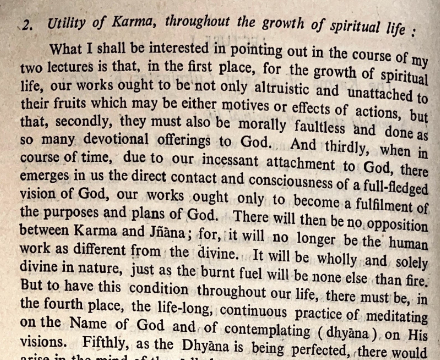What I shall be interested in pointing out in the course of my two lectures is that, in the first place, for the growth of spiritual life, our works ought to be not only altruistic and unattached to their fruits which may be either motives or effects of actions, but that, secondly, they must also be morally faultless and done as so many devotional offerings to God. And thirdly, when in course of time, due to our incessant attachment to God, there emerges in us the direct contact and consciousness of a full-fledged vision of God, our works ought only to become a fulfilment of the purposes and plans of God. There will then be no opposition between Karma and Jñana; for, it will no longer be the human work as different from the divine. It will be wholly and solely divine in nature, just as the burnt fuel will be none else than fire. But to have this condition throughout our life, there must be, in the fourth place, the life-long, continuous practice of meditating on the Name of God and of contemplating (dhyāna) on His visions. Fifthly, as the Dhyana is being perfected, there would arise in the mind of the sadhaka a natural disgust (Vairagya) for all the Godless things in the world, including the considerations of one’s own body and belongings. And, finally, with the divine light inside and outside, and the consequent energy, joy and peace, one comes to know the full significance of the Grace of God, and becomes ever loyal to Him with all his love and gratitude. Grace in the beginning, grace in the middle and grace at the end becomes the final discovery of man, and he clings to it to the end of his life.
My lectures are mainly based on my study of the Bhagavadgita, though the general background is the result of several other factors. I know that the Gita contains many contradictory statements and ambiguities of words and phrases, and that it is this fact which is responsible for the world-wide differences of opinions regarding its central topic. I have pointed out in the preface of my recent book, ‘The Brahma-yoga of the Gita’, that various answers can be given to the single question, ‘what is the central topic in the Bhagavadgita?’ “Duty for duty’s sake; achieving the social good by being active throughout one’s life; self-sacrifice for the purpose of self-realisation; propitiation of deities by means of penance, sacrifice and charity; leading the life according to the rules of castes and aśramas; resorting to Yoga in order to attain the Asamprajñāta Samādhi; philosophic contemplation upon the nature of the Absolute in order to go beyond the three gunas; thinking always that one is identical with Brahman; meditating always on the symbols of Brahman, such as the Sun, the moon etc; to achieve the moral virtues one after another; all such and several other answers can be given to that single question. But all this, we think, will only bewilder the intellect, especially so, on the background of some kind of miserable plight in saṁsāra, as it occurred in the case of Arjuna. What the Gità offers as a remedy is not a multitude of them, some of which are mere speculative, some hazardous or dangerous, and some other attractive and useful to some extent, though ultimately illusive and unreal. ” I feel however glad that due to the direct and indirect guidance of many a great realized soul, these very contradictions and ambiguities have enabled me to discover in the Gita a unity of purpose and plan, a part only of which I wish to depict to-day and tomorrow in as broad an outline as would be possible for me during the time at my disposal. To a casual listener and to a mere intellectualist, some of the statements about spiritual life are bound to appear as dogmatic; but the truth would dawn on them who wish to make a search for themselves. For, the life of the Spirit is primarily a personal experiment; it is afterwards that one can compare his notes with others who might have made a similar search for themselves.

